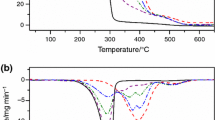Abstract
During the last years, the demand for biofuels has increased significantly. In Brazil, a production of 1 billion liters of biodiesel was produced by the end of 2007, due to its obligatory use in the composition of the diesel for vehicle use. In this production, a hundred thousand tons of glycerol are produced as by-product, for which alternative uses are needed. As glycerol has already been studied by other conventional characterization methods in the past, thermal analysis has been used mostly for characterization of sub ambient temperature properties of glycerol. In this paper, thermogravimetry (TG), derivative thermogravimetry (DTG) and differential thermal analysis (DTA) were used for its thermal characterization above room temperature. Thermal stability was determined from experimental data, which show that even in air, only a very small part of the volatilized glycerol is burned out. A thermogravimetric quantitative method was developed to determinate the water content of glycerol–water mixtures, which also was used to quantify the water impurity in pro-analysis samples of glycerol, showing compatible results with those obtained by Karl Fischer method.




Similar content being viewed by others
References
ANP. Brazilian National Agency of Petroleum: Resolution 30, (9/20/2004), 1–3 (in Portuguese).
Brazilian Ministery of Mines and Energy: 11097 Law, Offic. Union Journ. (D.O.U.), January 14th 2005, p. 8 (in Portuguese).
ASTM American Society for Testing and Materials: ASTM D6751-02 specification for biodiesel fuel blend stock (B100) for middle distillate fuels (2002).
Brazilian National Program for Biodiesel Production and Use – The Biodiesel: www.biodiesel.gov.br (August 2008) (in Portuguese).
Glycerol generated in biodiesel production will have new applications: www.biodieselbr.com/noticias/biodiesel/glicerina-gerada-producao-biodiesel-novos-usos-29-03-07.htm (2007) (in Portuguese).
Bouças C. Glycerol from biodiesel floods the market in the country and knocks prices. Valor Journ. p. B7. RJ, Brazil, May 2nd 2007 (in Portuguese).
Monteiro NA Jr. Subtitution strategy of imported diesel by biodiesel and eventual implications. M.Sc. Thesis. Rio de Janeiro: School of Chemistry, UFRJ; 2005. 235 p (in Portuguese).
Morrison R, Boyd R. Organic chemistry. 6th ed. Lisbon, Portugal: Calouste Gulbenkian Foundation; 1978 (in Portuguese).
Allinger N. Organic chemistry. 2nd ed. Rio de Janeiro, Brazil: Livros Técnicos e Científicos; 1979 (in Portuguese).
Oxford University. Safety data for glycerol (11/24/06). http://ptcl.chem.ox.ac.uk/MSDS/GL/glycerol.html. (2008).
Perry RH, Green DW. Perry’s chemical engineers handbook. 7th ed. McGraw-Hill; 1997, p. 2–116.
Quijada-Garrido I, Iglesias-Gonzalez V, Mazon-Arechederra JM, Barrales-Rienda JM. The role played by the interactions of small molecules with chitosan and their transition temperatures. Glass-forming liquids: 1,2,3-Propanetriol (glycerol). Carbohydr Polym. 2007;68(1):173–86.
Ramiz-Galvão BF. Etymological, spelling and prosodic vocabulary of the Portuguese words derived from the Greek language. Rio de Janeiro: Francisco Alves; 1909 (in Portuguese).
Schlemmer D, de Oliveira ER, Araújo Sales MJ. Polystyrene/thermoplastic starch blends with different plasticizers. J Therm Anal Calorim. 2007;87(3):635–8.
Fangrui M, Hanna MA. Biodiesel production: a review. Bioresour Technol. 1999;70:1–15.
Ryabov YE, Hayashi Y, Gutina A, Feldman Y. Features of supercooled glycerol dynamics. Phys Rev B. 2003;67(13):132202/1–/4.
Margolis SA. Sources of systematic bias in the measurement of water by the coulometric and volumetric Karl Fischer methods. J Am Chem Soc Anal Chem. 1997;69(23):4864–71.
Hu L, Yang M, Wang C. Determination of the concentrations of binary mixtures of glycerin and water by a transient method. J Therm Anal Calorim. 1988;53(3):855–9.
Dweck J, Sampaio CMS. Analysis of the thermal decomposition of commercial vegetable oils in air by simultaneous TG/DTA. J Therm Anal Calorim. 2004;75(2):385–91.
Vecchio S, Campanelle L, Nuccilli A, Tomassetti M. Kinetic study of thermal breakdown of triglycerides contained in extra-virgin olive oil. J Therm Anal Calorim. 2008;91(1):51–6.
Hayashi Y, Puzenko A, Balin I, Ryabov YE. Relaxation dynamics in glycerol-water mixtures. 2. Mesoscopic feature in water rich mixtures. J Phys Chem B. 2005;109(18):9174–7.
Hayashi Y, Puzenko A, Feldman Y. Ice nanocrystals in glycerol-water mixtures. J Phys Chem B. 2005;109:16979–81.
Inaba A, Anderson O. Multiple glass transitions and two step crystallization for the binary system of water and glycerol. Thermochim Acta. 2007;461(1–2):44–9.
Remião F. Acrolein. Toxicology and toxicological analysis monograph. Pharmaceutics School, Porto University; 2005.
Kissinger HE. Reaction kinetics in differential thermal analysis. J Am Chem Soc Anal Chem. 1957;29(11):1702–6.
Acknowledgements
Our acknowledgements to the Brazilian Research Council (CNPq), the Chemical School of the Federal University of Rio de Janeiro (UFRJ), and to the Fluminense Federal Institute – campus Macaé.
Author information
Authors and Affiliations
Corresponding author
Rights and permissions
About this article
Cite this article
Castelló, M.L., Dweck, J. & Aranda, D.A.G. Thermal stability and water content determination of glycerol by thermogravimetry. J Therm Anal Calorim 97, 627–630 (2009). https://doi.org/10.1007/s10973-009-0070-z
Published:
Issue Date:
DOI: https://doi.org/10.1007/s10973-009-0070-z




